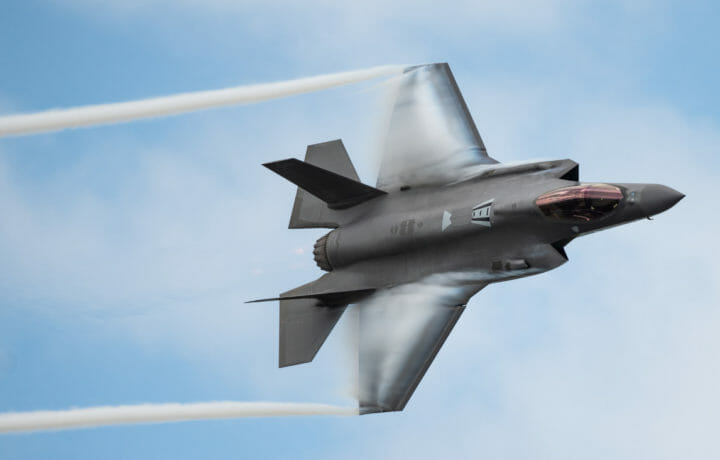Despite being in service with the United States Air Force, Navy and Marine Corps, the Lockheed Martin F-35 Lightning II Joint Strike Fighter still hasn’t entered full-rate production, and earlier in January it was announced that the Pentagon has extended the deadline to complete sign-off on the fifth-generation aircraft.
The news didn’t come as a complete surprise, as the former Pentagon acquisition and sustainment Undersecretary Ellen M. Lord had signed an Acquisition Decision Memorandum just before the Christmas holiday to extend the Milestone C decision. That is still necessary to certify that the F-35 had successfully completed initial operational tests and evaluation.
“Delays in maturing the Joint Simulation Environment (JSE) – caused by technical challenges and the impact of COVID-19 – will prevent the completion of F-35 Block 3F Milestone C,” the memo stated, according to a report from Air Force Magazine. As a result, the F-35 Joint Program Office will now have to set a new schedule for both benchmarks, which Lord had said will be based on an independent technology review, as well as measured progress in the JSE.
This was the third such postponement for the F-35.
Issues that will be factored into the decision include the need for rare earth metals that are used in components of the F-35 as well as how the Covid-19 pandemic could cause delays in production.
Negotiations Continue
Even as the advanced stealth aircraft hasn’t actually reached its full rate of production, the F-35 Joint Program Office (JPO), the aircraft’s primary contractor Lockheed Martin, and engine maker Pratt & Whitney have begun to negotiate prices for the 15th through 17th lots of the aircraft and its engines.
According to the JPO, this contracting strategy is to negotiate a “base year” for Lot 15, with “two-single year options” for Lots 16 and 17.
Lockheed has quoted the price publicly for the Joint Strike Fighter with engines; however, the government actually negotiates those prices with engine marker. This strategy has been seen as a way for the F-35 to finally exit its engineering and manufacturing development stage and be declared ready for full-rate production.
What is also notable is that the Lot 15-17 contracts will also mark the first deals for Pratt & Whitney under its new ownership of Raytheon Technologies, which formally took over operations last April. The company had previously been owned by United Technologies.
Aircraft Still Being Produced
Even as the F-35 still hasn’t entered production, according to Lockheed Martin, as of January 2021, more than 610 aircraft have been delivered, and more than 1,255 pilots and 10,030 maintainers have been trained on the aircraft worldwide.
However, despite the numbers of aircraft produced, Lockheed Martin still fell short of the 2020 goal to produce 142 F-35s, and it has cited the Covid-19 pandemic disrupting the supply chain as a primary cause. It could take until at least 2023 for the manufacturer to catch up to the missed deliveries.
The aircraft is being operated by nine nations including the United States, and six services have conducted operation missiles with the F-35. Marine Fighter Attack Squadron (VMFA) 314 declared its initial operational capability (IOC) for the F-35C variant, the air carrier-capable catapult-launched version, in December 2020.
Block 4 Incremental Software Upgrades
It has also been announced that the Marine Corps’ F-35Bs, the short takeoff and vertical landing (STOVL) version, as well as the U.S. Navy’s F-35Cs are now set to receive the incremental Block 4 upgrades – which includes Block 4.1, 4.2 and onwards – within the next few months.
Lockheed Martin has described those Block 4 upgrades as a “Continuous Capability Development and Delivery,” not all that different from the all-too regular Windows 10 upgrades sent out by Microsoft to PC users. In the case of the F-35, the Block 4 upgrades will provide additional computing power, processing power, and memory than the current F-35 computers.
The software update will also reportedly improve the flexibility of the aircraft by allowing it to be armed with additional missiles with longer ranges. The increased computing power will enhance the F-35B’s and F-35C’s electronic warfare capabilities, allowing for the aircraft to better jam enemy radar and transmissions.
It will also allow the F-35 to operate an AI-based wingman, such as the Kratos XQ-58A Valkyrie Unmanned Combat Aircraft (UCA), via the U.S. Air Force’s Skyborg program.
Even with these upgrades, the biggest threat will likely remain ensuring that the aircraft can finally be certified for full-rate production, and that Lockheed Martin can catch up on missed orders.




